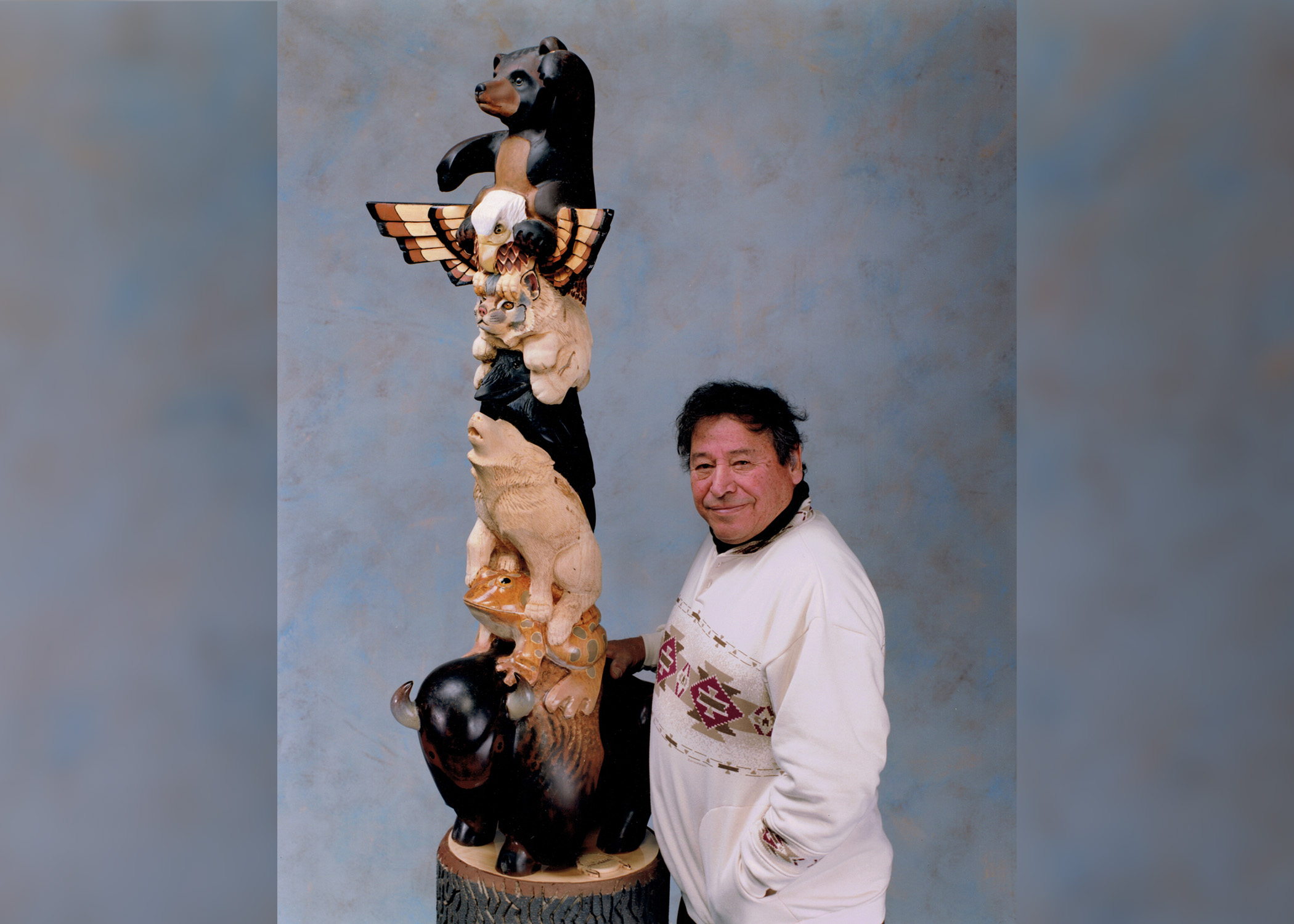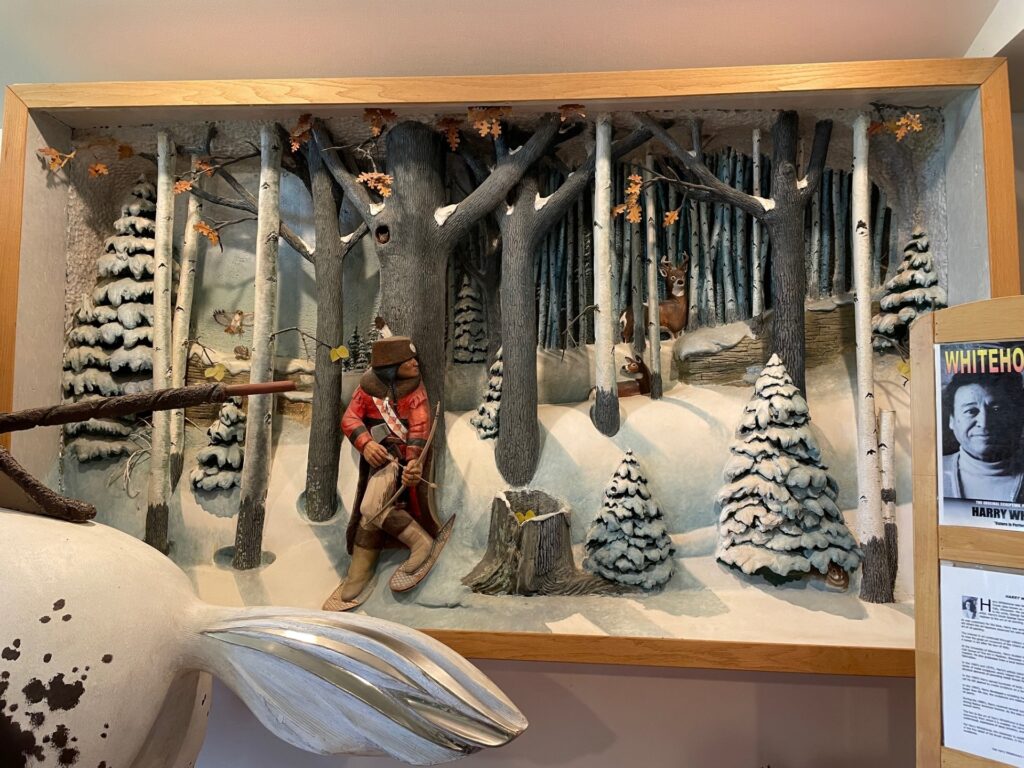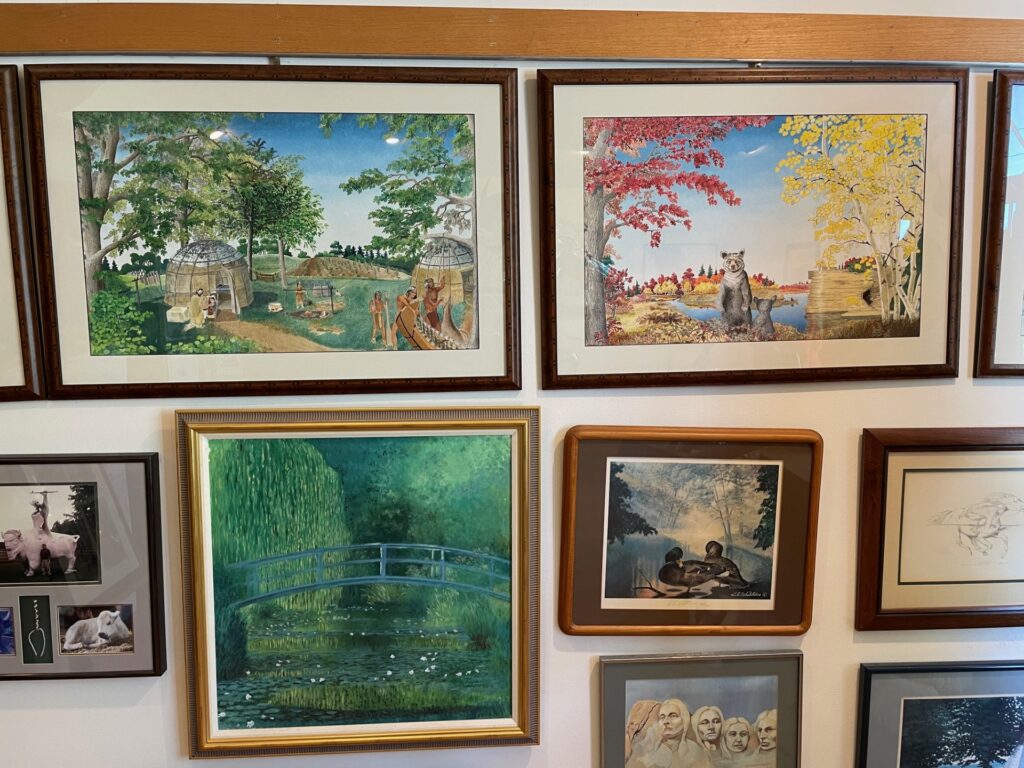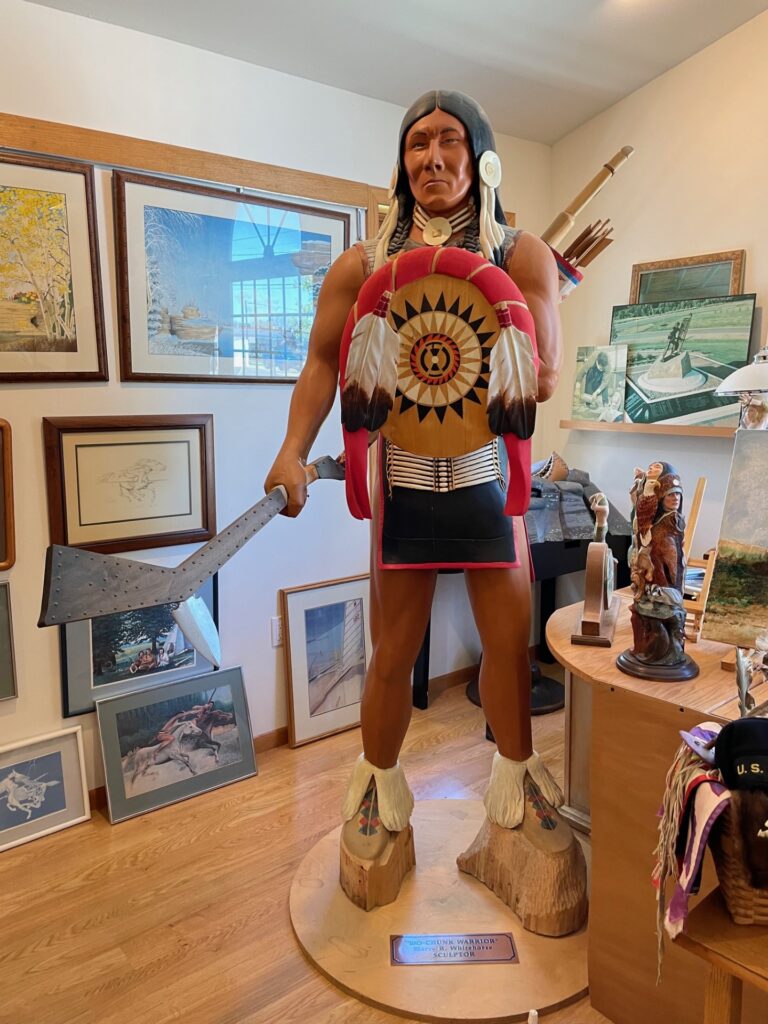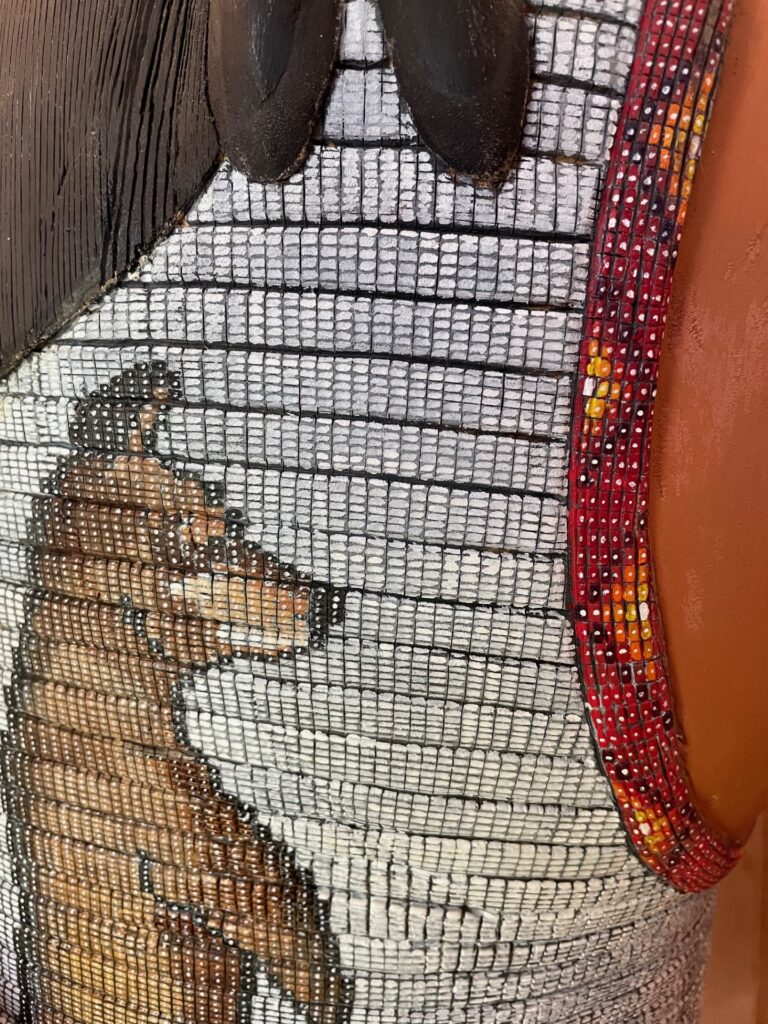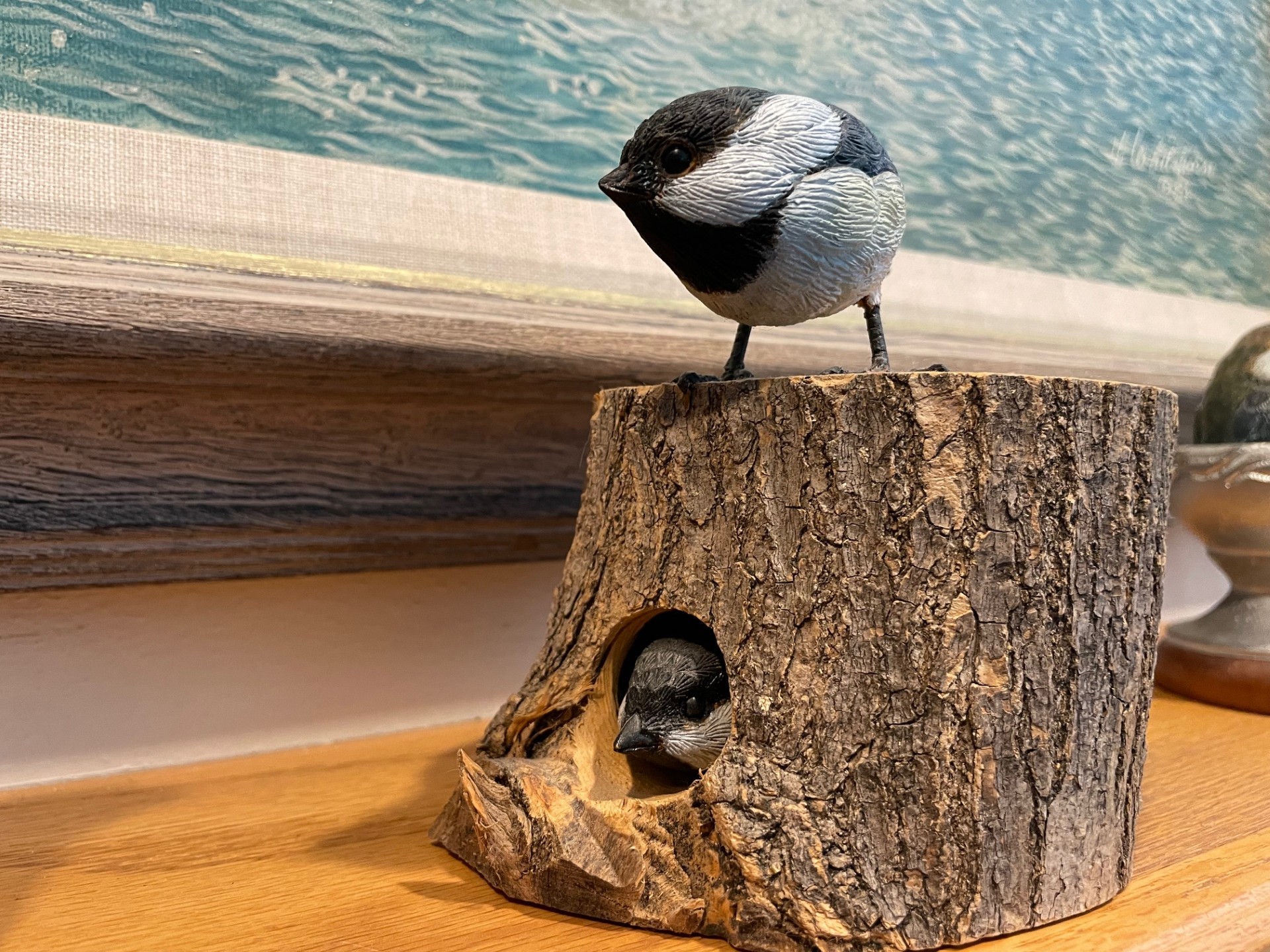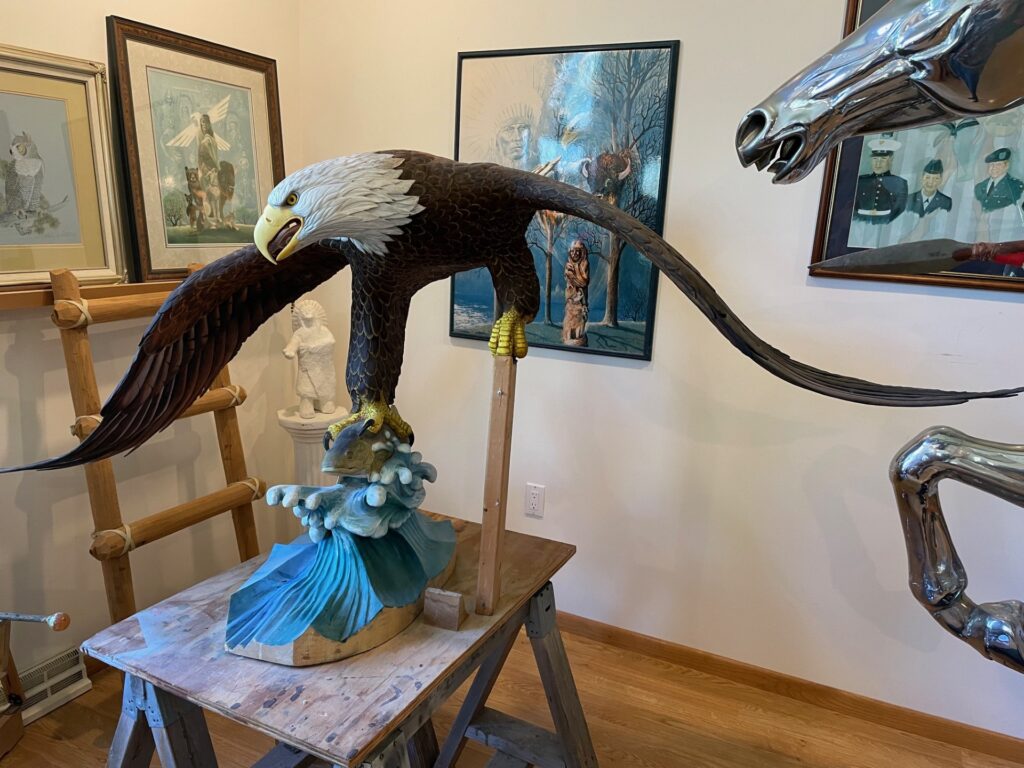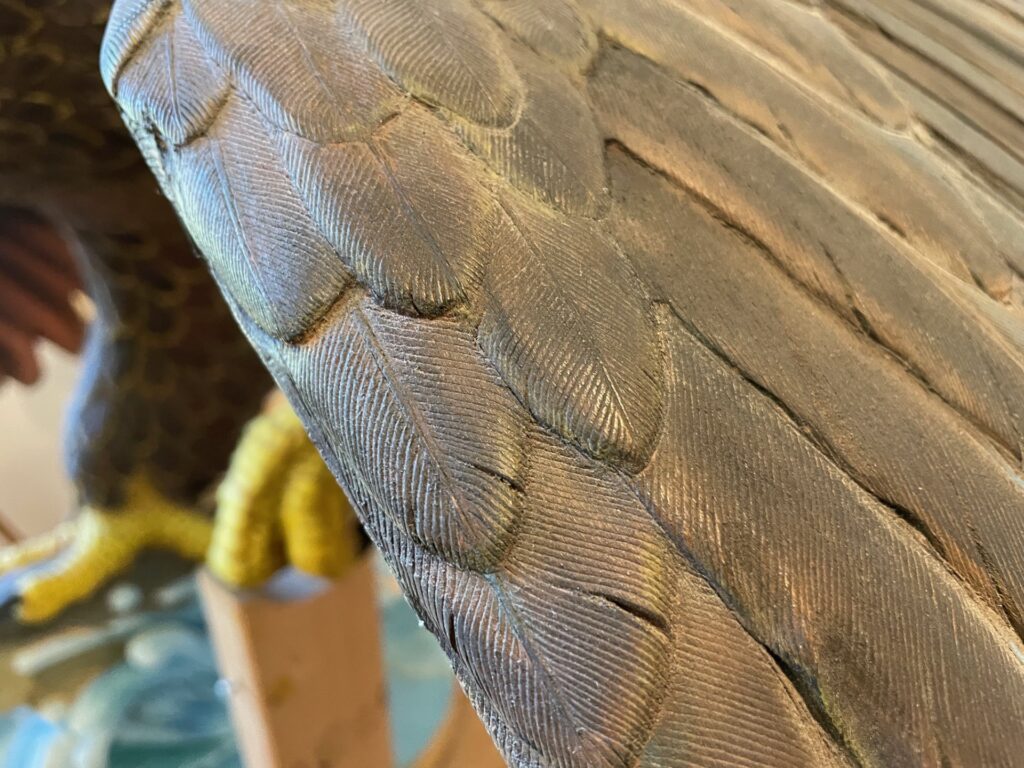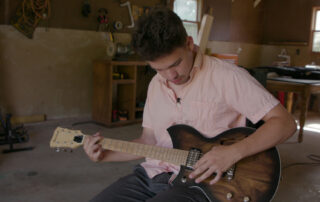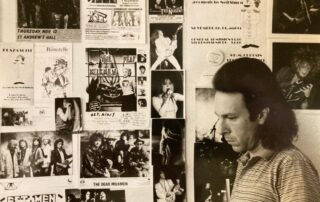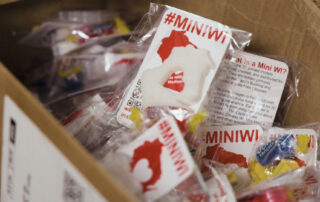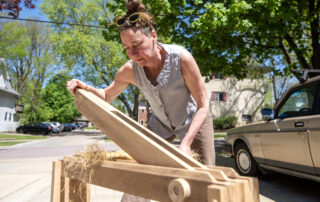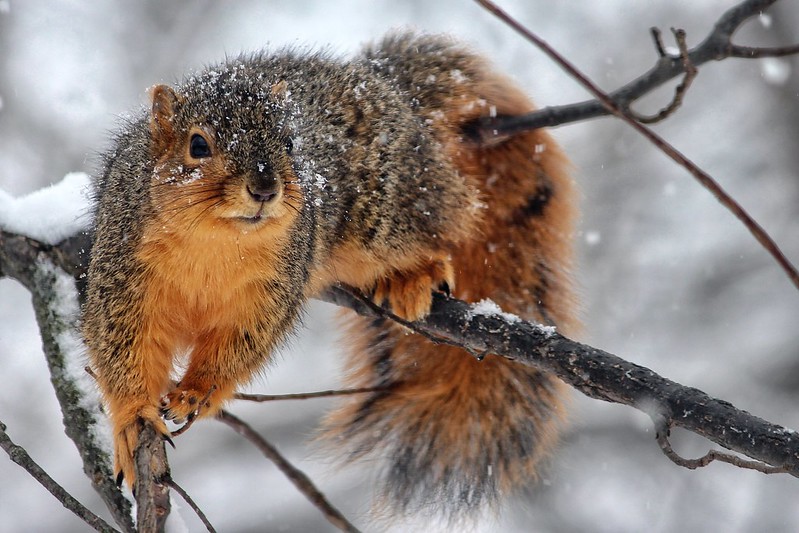When you walk into the sun-drenched studio of Harry Whitehorse, it’s immediately apparent how prolific he was as an artist. It’s also clear why a new festival, the Harry Whitehorse International Wood Sculpture Festival, is named in his honor.
On the left in the gallery is a wall covered in his paintings — natural landscapes featuring bears or his fellow Ho-Chunk members. And on the right, is a piece of art that can take your breath away.
“This is Ghost Warrior. The front half of the horse is metal. And he began that part in the early sixties,” said Deb Whitehorse, Harry’s wife, standing next to the 9 foot horse sculpture whose back half is Styrofoam painted white and brown like a pinto. “Sometime in the eighties, he had — I don’t know what you call it — a vision that this horse needed more.”
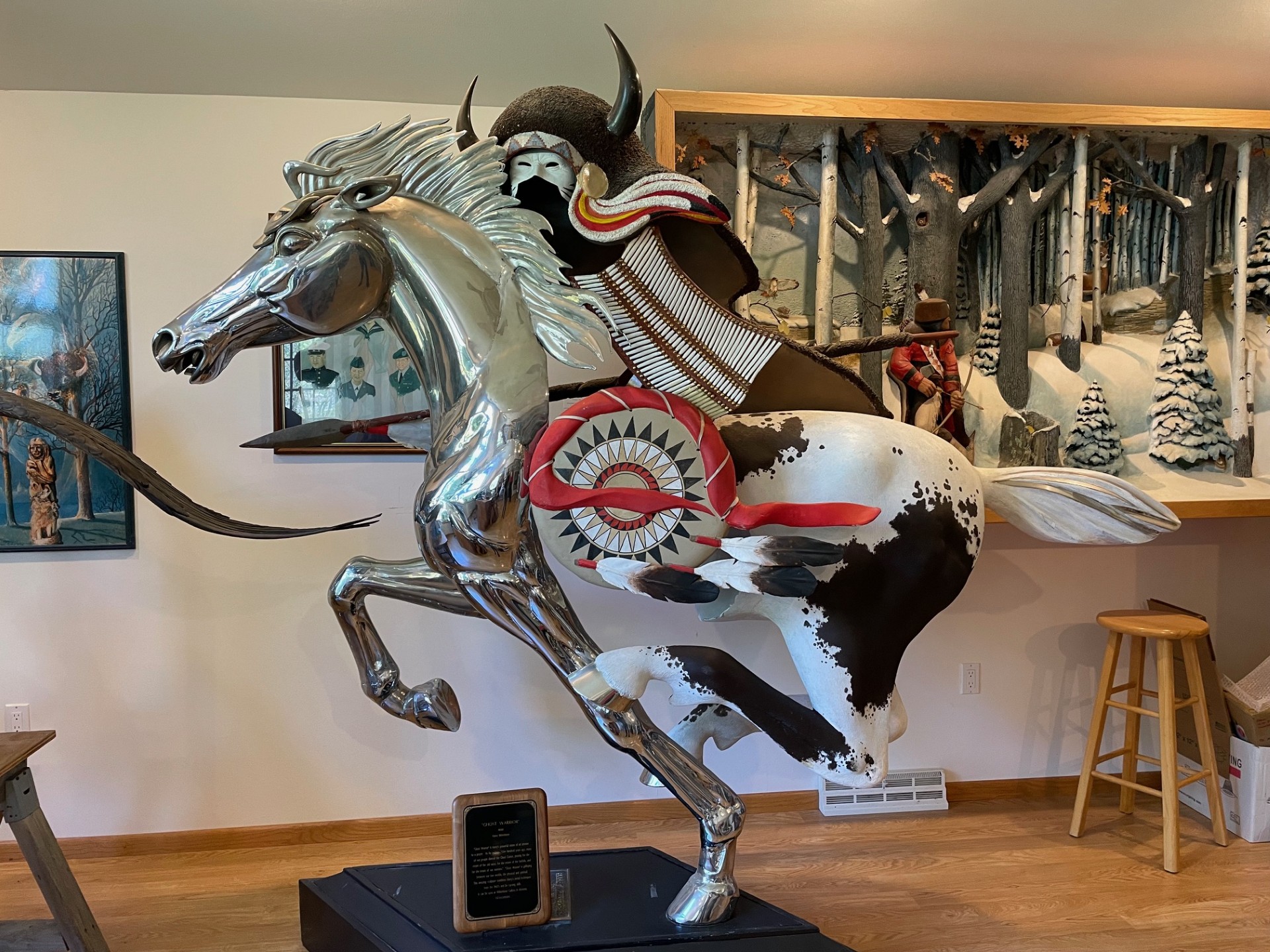
“Ghost Warrior” on display in the Whitehorse Gallery in Monona, Wisconsin. A plaque below it reads: “‘Ghost Warrior’ is Harry’s powerful vision of an answer to a prayer. As he explains, ‘One hundred years ago, many of our people danced the Ghost Dance, praying for the return of the old ways, for the return of the buffalo, and for the return of our warriors.’ ‘Ghost Warrior’ is galloping between our two worlds, the physical and spiritual. This amazing sculpture combines Harry’s metal techniques from the 1960s and his carving skills.” (Maureen McCollum/WPR)
So, Harry Whitehorse added the Ghost Warrior, an invisible figure riding the horse — you only see their clothing, shield and spear. It was inspired by a spirit horse in Eagle Heights Woods in Madison, Wisconsin.
“It’s a native warrior. His thought was it’s going in and out of the spirit world,” said Deb Whitehorse. “I think this is one of his favorite pieces. It meant a lot to him. It was exhibited quite a bit around the state of Wisconsin.”
Now, the piece is on display in this studio is in the Monona, Wisconsin home of Harry Whitehorse, who passed away in 2017 at age 90. Deb Whitehorse still lives here. Harry’s family lived on this property for decades.
- “Winter Hunters” by Harry Whitehorse is a mixed media diorama on display in the Whitehorse Gallery in Monona, Wisconsin. (Maureen McCollum/WPR)
- Paintings by Harry Whitehorse take up a wall in the Whitehorse Gallery in Monona, Wisconsin. (Maureen McCollum/WPR)
A creative, artistic life
Harry Whitehorse was born in 1927 in Black River Falls, Wisconsin. During his childhood, his family would often visit south central Wisconsin.
“They had always camped here. They lived kind of a traditional Ho-Chunk life back in the 1920s and 1930s. They would follow the cherry harvest, potato harvest, and visit relatives all around the state,” said Deb Whitehorse. “At that time, farmers would let them camp on their property. Sometime in the twenties and thirties, that stopped. So they saw the writing on the wall and bought this property here.”
When the family first moved to the area in 1932, they lived in a traditional Ho-Chunk ciiporoke and eventually built more houses around what is now East Broadway in Monona. They trapped muskrat and beaver in the marshland and Harry’s job was to bag the animals they caught. The family also created a lot of art. Harry’s uncle, artist George Seymour, taught him a life changing skill: woodcarving.
- “Ho-Chunk Warrior,” a wood sculpture by Harry Whitehorse. It’s on display in the Whitehorse Gallery in Monona, Wisconsin. (Maureen McCollum/WPR)
- Close up of “Ho-Chunk Warrior” by Harry Whitehorse shows how the carvings on the back of the vest look like beadwork. (Maureen McCollum/WPR)
“It was traditional, common among Ho-Chunk families to have basket stands where they would make baskets out of black ash and other things and sell them. This was how Harry got started in art,” said Deb Whitehorse. “His uncle, George Seymour, who was his mentor, taught him to carve and make things out of little pieces of metal. So right here on the road, they set up a basket stand.”
When Harry Whitehorse got older, he served in the U.S. Navy during World War II. While on leave, many of his fellow sailors would head to the European taverns for a good time. Not Harry.
“Instead, he would go into the museums and look at the sculptures. At that point, he said, ‘Well, that’s what I’m going to do,” said Deb Whitehorse.
After the war, Harry Whitehorse returned to Wisconsin to pursue a career as an artist. He went to the Arthur Colt School of Fine Arts in Madison to study oil painting and studied human and animal anatomy at University of Wisconsin. He also got his degree in welding and metal fabrication at Madison Area Technical College to become an auto mechanic.

Harry Whitehorse poses in front of one of the custom cars he built in Monona, Wisconsin. (Photo by Gary Whitehorse)
Harry Whitehorse and his brother, Walter Whitehorse, started Chief Auto Parts and Chief Auto Body on their family’s land in Monona. They made a living fixing, building and recycling cars while raising their families. Harry found ways to meld his mechanic and artistic worlds together by creating metal sculptures and building (and racing) custom cars.
“Harry seemed like he was doing work all the time. He had art going all the time and I admire that,” said Gene Delcourt, a Madison artist and educator. When Delcourt was pursuing his MFA at UW-Madison in the early 1990s, he became interested in woodcarving. A professor recommended he work with Harry Whitehorse, who had recently returned to woodworking. Harry quickly became Delcourt’s mentor. They worked together out of Harry’s home while listening to classical music.
“We started carving little birds. I spent the whole winter doing that with him,” remembered Delcourt. “I would show him what I’ve done and he’d say, ‘Okay, birds have ears, and there’s just a little tiny ridge that you want to carve out and then it sand just so that it hints of that ridge. Same with the beak…he just showed me how to do it with a knife. We were just using jack knives back then. (We) didn’t have any carving tools.”
With Harry Whitehorse’s mentorship, Delcourt eventually graduated to using a wood burner and chainsaw. Both artists started carving larger wooden sculptures. They were also traveling the country to snow carve together.
“When we were working with each other, he’d always buy me something to drink. Give me lunch. I didn’t expect any of that,” said Delcourt. “He was just a very nice man. He referred to me and John (Thundercloud) as his grandsons once, and that really made me feel good.”
Harry Whitehorse also encouraged Delcourt to start participating in wood carving symposiums around the world, where Delcourt created sculptures inspired by nature and his Abenaki heritage.
- “Fishing Eagle” by Harry Whitehorse was carved from basswood and finished with oil paints. (Maureen McCollum/WPR)
- A closeup on “Fishing Eagle” by Harry Whitehorse shows how the intricate carving of the feather makes it appear real. (Maureen McCollum/WPR)
Foundations of a festival
Harry Whitehorse passed away in November 2017 at age 90. His artwork can still be seen throughout the Madison area.
But Deb Whitehorse and Gene Delcourt want his legacy to live on in other ways. Delcourt thought back on the experiences he had at the European wood carving symposiums and thought, “Why not start one in Wisconsin?”

Harry Whitehorse poses next to his sculpture “Superior Spirits,” which is carved from yellow birch. It’s currently on display in the WHEDA building in Madison, Wisconsin. (Courtesy of Deb Whitehorse)
“So when my wife (Stacy Levin) and I finally said that we must do this, it was a no brainer for me. It has to be named after Harry because he was so instrumental in me getting into this wood sculpture world.”
The Harry Whitehorse International Wood Sculpture Festival will feature a dozen sculptors from around the world from June 14-22, 2024. Inside willow branch structures, the artists will spend the week carving oak, pine or basswood sculptures along Lake Monona at San Damiano Monona. Ho-Chunk artists will also be creating baskets and showing jewelry, quill work and other art throughout the week. The event is open to the public.
Delcourt, who is founder and president of the festival, will also be one of the sculptors.
“I hope that this will become part of (Harry’s) legacy. If it’s successful, as we hope it is, it’ll happen again,” said Delcourt. “It would be a dream come true and sort of a mission of my life to make this an annual thing that happens beyond me.”
Delcourt is hoping that they can eventually create a wood sculpture garden in Madison in Harry Whitehorse’s honor.
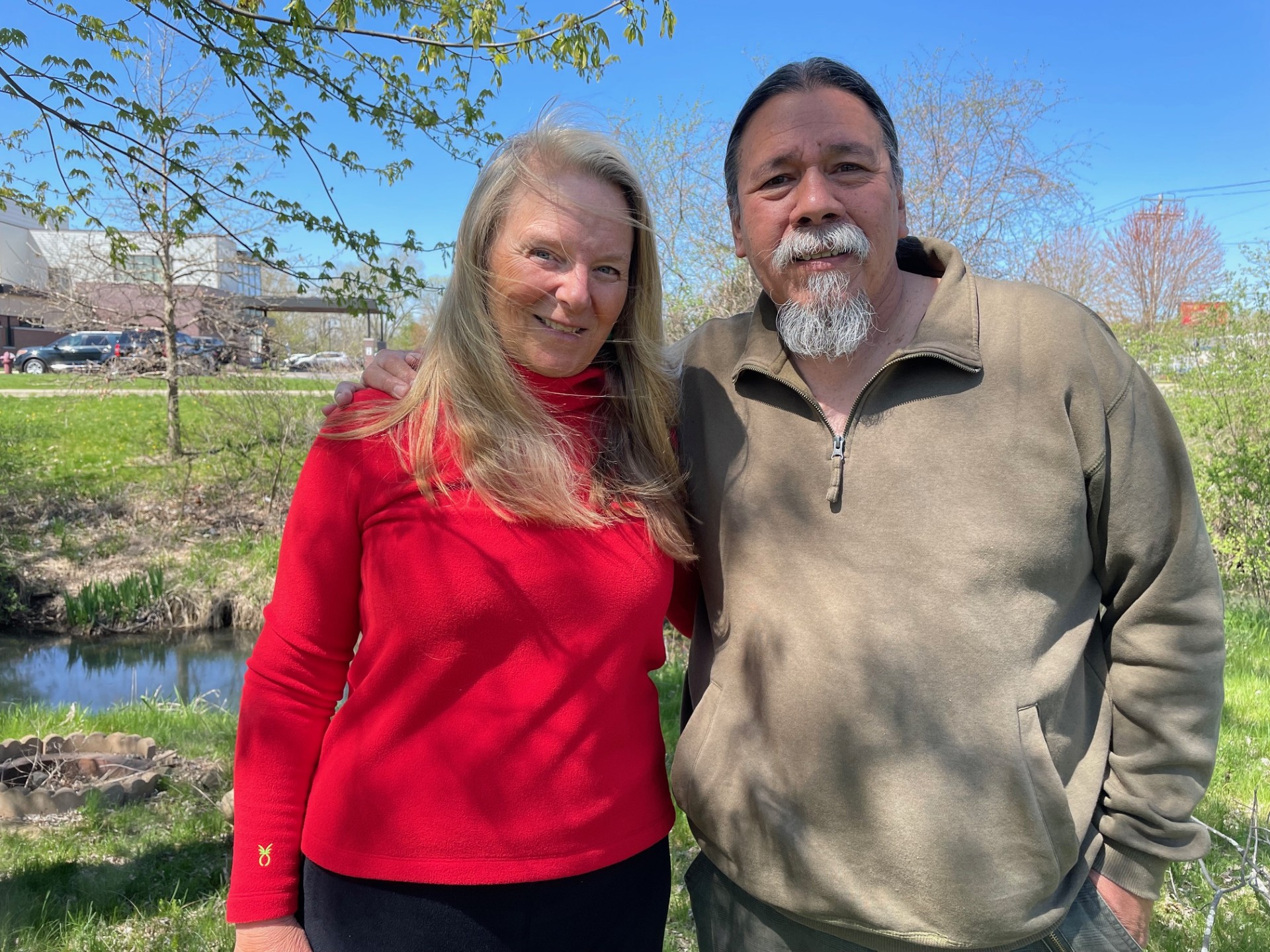
Deb Whitehorse and Gene Delcourt outside Deb’s home in Monona, Wisconsin. In the background is UW Health’s Yahara Clinic, which features Harry Whitehorses’s steel sculpture “Asclepius, The Greek God of Healing.” (Maureen McCollum/WPR)
Deb Whitehorse, who’s the vice president of the festival, said the festival means a lot for her husband’s legacy.
“He died about six years ago and it’s always been on my mind, ‘I hope everybody remembers him.’ He not only was an artist, he was a Ho-Chunk person. He’s a Navy veteran. Just an amazing individual,” said Deb Whitehorse. “He was very nonchalant about these things. He was a very humble person. He was never one to give a long speech about what the piece means to him and so forth, other than he knew he was inspired by nature. He would rather talk about the process.”
Other than introducing more people to Harry Whitehorse’s work and platforming international wood sculptors, Deb Whitehorse said she hopes the Wood Sculpture Festival will inspire more people to be creative.
“This (is) just the answer to a prayer — that we’re doing something so people remember him, ask about him and and know about him,” said Deb Whitehorse. “Hopefully, (it) inspires other artists and young people. There are so many opportunities to be creative in Madison and (we hope) they take advantage of that and they have the drive to create every day.”
Just like Harry Whitehorse.
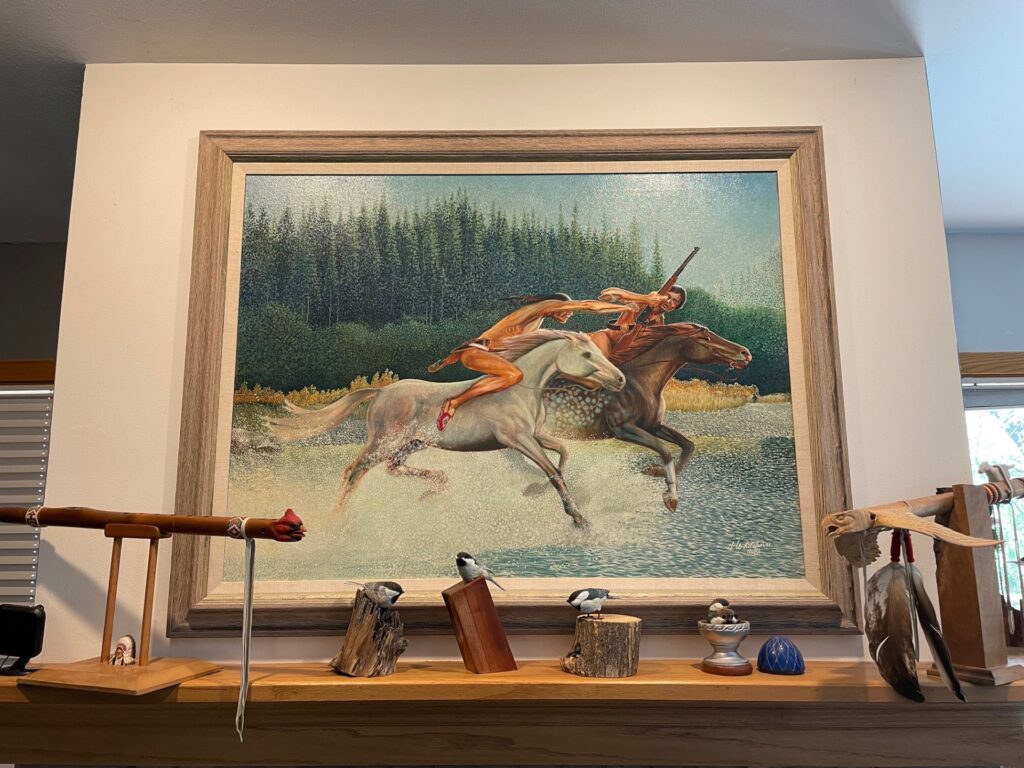
The oil painting “Under Indian Police Arrest” by Harry Whitehorse hangs in the living room of Deb Whitehorse’s home. On the mantle is a collection of birds and flutes carved by Harry. In the 1990s, Deb and Harry built this Monona, Wisconsin home, which also features the Whitehorse Gallery. (Maureen McCollum/WPR)
